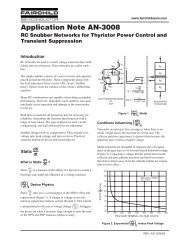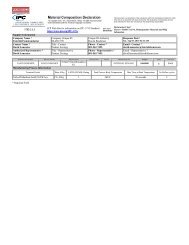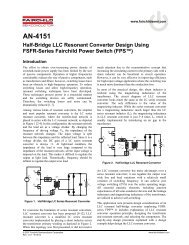AN-9732 - Fairchild Semiconductor
AN-9732 - Fairchild Semiconductor
AN-9732 - Fairchild Semiconductor
You also want an ePaper? Increase the reach of your titles
YUMPU automatically turns print PDFs into web optimized ePapers that Google loves.
<strong>AN</strong>-<strong>9732</strong> APPLICATION NOTE<br />
2.<br />
5 115mho<br />
fI<br />
<br />
V 2<br />
C<br />
f<br />
CP<br />
OUT<br />
<br />
2<br />
R<br />
COMP<br />
GM 115 mho<br />
COMP,<br />
LF<br />
1<br />
C<br />
COMP,<br />
HF<br />
[ Hz]<br />
[ Hz]<br />
Figure 27. Compensation Network<br />
(31)<br />
The feedback resistor is chosen to scale down the output<br />
voltage to meet the internal reference voltage:<br />
R<br />
R<br />
FB1<br />
FB1<br />
R<br />
FB2<br />
V<br />
OUT<br />
2.<br />
5V<br />
(32)<br />
Typically, high RFB1 is used to reduce power consumption<br />
and, at the same time, CFB can be added to raise the noise<br />
immunity. The maximum CFB currently used is several nano<br />
farads. Adding a capacitor at the feedback loop introduces a<br />
pole as:<br />
f<br />
FP<br />
<br />
2<br />
<br />
1<br />
<br />
2<br />
R<br />
1<br />
R// R <br />
FB1<br />
FB2<br />
C<br />
FB<br />
where R// R <br />
FB1<br />
FB2<br />
C<br />
[ Hz]<br />
FB<br />
RFB1<br />
RFB2<br />
FB2<br />
<br />
RFB1<br />
RFB2<br />
(33)<br />
Though RFB1 is high, pole frequency made by the<br />
synthesized total resistance and several nano farads is<br />
several kilo hertz and rarely affects control-loop response.<br />
The procedure to design the feedback loop is:<br />
a. Determine the crossover frequency (fC) around<br />
1/10~1/5 of line frequency. Since the control-tooutput<br />
transfer function of the power stage has<br />
-20dB/dec slope and -90 o phase at the crossover<br />
frequency, as shown in Figure 28; it is required to<br />
place the zero of the compensation network (fCZ)<br />
around the crossover frequency so 45 phase<br />
margin is obtained. The capacitor CCOMP,LF is<br />
determined as:<br />
V <br />
2<br />
KSAW<br />
LINE 2.<br />
5 115mho<br />
CCOMP,<br />
LF [ f ]<br />
2<br />
2 (34)<br />
2VOUT<br />
L<br />
COUT2fC<br />
To place the compensation zero at the crossover<br />
frequency, the compensation resistor is obtained as:<br />
1<br />
<br />
2<br />
f C<br />
© 2011 <strong>Fairchild</strong> <strong>Semiconductor</strong> Corporation www.fairchildsemi.com<br />
Rev. 1.0.0 • 3/23/11 14<br />
R<br />
COMP<br />
C<br />
COMP,<br />
LF<br />
[ ]<br />
(35)<br />
b. Place this compensator high-frequency pole (fCP) at<br />
least a decade higher than fC to ensure that it does<br />
not interfere with the phase margin of the voltage<br />
regulation loop at its crossover frequency. It should<br />
also be sufficiently lower than the switching<br />
frequency of the converter for noise to be<br />
effectively attenuated. The capacitor CCOMP,HF is<br />
determined as:<br />
C<br />
COMP,<br />
HF<br />
1<br />
[ ]<br />
(36)<br />
2<br />
f R<br />
CP<br />
COMP<br />
Figure 28. Compensation Network Design







